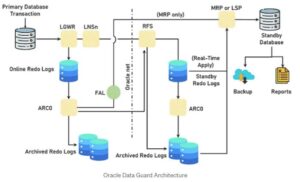Oracle Data Guard is a powerful solution for achieving high availability, data protection, and disaster recovery in Oracle databases. In this article, we’ll delve into the architecture of Oracle Data Guard, with a focus on the relationship between primary and standby databases. By the end, you’ll understand how the components work together to maintain a robust environment, and we’ll even cover some scripts to help you manage your Data Guard configuration.
What is Oracle Data Guard?
Oracle Data Guard is a feature in Oracle databases that allows for the creation of one or more standby databases as backups for a primary database. In the event of a failure or maintenance event, Oracle Data Guard enables a smooth switchover or failover to a standby database, ensuring minimal downtime and data loss. Oracle Data Guard supports both physical and logical standby databases, allowing flexibility based on business requirements.

Key Components of Oracle Data Guard Architecture
Understanding the components and processes involved in Oracle Data Guard is crucial. Here are the main elements:
- Primary Database: The production database where all transactions occur.
- Standby Database: A synchronized replica of the primary database, kept up-to-date with redo logs.
- Redo Logs: Logs that capture every change in the primary database, ensuring no data is lost in case of a switch to the standby.
- Archive Logs: Copies of redo logs that allow the standby database to replay changes and stay in sync with the primary.
- Network Configuration (Oracle Net): Facilitates the transfer of redo logs between primary and standby databases.
Data Guard Processes
Several Oracle background processes work together to manage data replication and ensure consistency between the primary and standby databases:
- LGWR (Log Writer): Writes redo entries from the redo buffer to the online redo log files in the primary database.
- LNS (Log Network Server): Assists LGWR by transmitting redo data to the standby’s Remote File Server (RFS) process.
- RFS (Remote File Server): Receives redo logs sent from the primary database and writes them to the standby redo logs.
- MRP (Managed Recovery Process): Applies the redo logs on the standby, ensuring it remains synchronized with the primary.
- FAL (Fetch Archive Log): Located on the standby, this process requests missing logs from the primary in case of gaps.
Data Guard Configuration Modes
Oracle Data Guard operates in two primary modes for log transmission and application, which impact recovery time and data loss risk:
- Synchronous Mode (SYNC): Ensures zero data loss by confirming redo log receipt on the standby before committing on the primary. This mode is ideal for critical applications.
- Asynchronous Mode (ASYNC): Prioritizes performance by allowing transactions to commit on the primary without waiting for acknowledgment from the standby. Some data loss may occur in case of failure.
Setting Up Oracle Data Guard
Now, let’s go through the basic steps for configuring a Data Guard environment.
1. Enable Archiving on the Primary Database
First, you need to make sure archiving is enabled on the primary database. Run the following SQL commands to verify and enable archiving:
ALTER SYSTEM SET log_archive_dest_1='LOCATION=/u01/app/oracle/archive' SCOPE=SPFILE;
ALTER SYSTEM SET log_archive_dest_state_1=ENABLE;
ALTER SYSTEM SET log_archive_format='%t_%s_%r.arc';
2. Configure Redo Log Transport to the Standby Database
To configure the transport of redo logs from the primary to the standby database, define the standby destination:
ALTER SYSTEM SET log_archive_dest_2='SERVICE=standby_db ASYNC NOAFFIRM VALID_FOR=(ONLINE_LOGFILES,PRIMARY_ROLE) DB_UNIQUE_NAME=standby_db' SCOPE=SPFILE;
3. Configure Standby Redo Logs
On the standby database, configure the standby redo logs to ensure seamless log application. The standby redo logs should match the size and number of the primary’s redo logs.
ALTER DATABASE ADD STANDBY LOGFILE THREAD 1 GROUP 10 ('/u01/app/oracle/oradata/standby/redo10.log') SIZE 50M;
ALTER DATABASE ADD STANDBY LOGFILE THREAD 1 GROUP 11 ('/u01/app/oracle/oradata/standby/redo11.log') SIZE 50M;
4. Start Data Guard Services
Once configured, start the managed recovery on the standby database to begin the application of redo logs in real-time.
ALTER DATABASE RECOVER MANAGED STANDBY DATABASE USING CURRENT LOGFILE DISCONNECT;
Monitoring Data Guard
To ensure your Data Guard setup is functioning correctly, you should regularly monitor the status of the primary and standby databases. Use the following queries for monitoring:
Check the Data Guard Role
SELECT DATABASE_ROLE, PROTECTION_MODE FROM V$DATABASE;
Verify Log Shipping Status
SELECT DEST_ID, STATUS, ERROR FROM V$ARCHIVE_DEST WHERE TARGET='STANDBY';
Monitor Log Apply Progress on the Standby
SELECT SEQUENCE#, APPLIED FROM V$ARCHIVED_LOG ORDER BY SEQUENCE#;
Performing a Switchover and Failover
In case of a planned maintenance event or a disaster, you may need to switch roles between the primary and standby databases. A switchover is a planned role reversal, while a failover is an unplanned switch that occurs in response to an outage.
Switchover Procedure
On the primary database:
ALTER DATABASE COMMIT TO SWITCHOVER TO STANDBY WITH SESSION SHUTDOWN;
On the standby database:
ALTER DATABASE COMMIT TO SWITCHOVER TO PRIMARY;
Failover Procedure
If the primary database becomes unavailable, you can initiate a failover on the standby:
ALTER DATABASE RECOVER MANAGED STANDBY DATABASE FINISH FORCE;
ALTER DATABASE ACTIVATE STANDBY DATABASE;
Conclusion
Oracle Data Guard provides robust disaster recovery and high availability capabilities for Oracle databases. By understanding its architecture and processes, you can set up, monitor, and manage a Data Guard environment to meet your organization’s data protection needs. Proper configuration and regular monitoring ensure that your standby database is ready to take over whenever needed, reducing downtime and protecting critical data.
Hopefully, this guide has demystified the Data Guard setup and its inner workings. For further insights into advanced configurations, stay tuned to our blog for more Oracle database tips and best practices.
3 Comments
I am really impressed with your writing abilities and also with the format for your weblog.
Is this a paid subject or did you modify it yourself?
Anyway keep up the excellent high quality writing,
it is rare to look a great weblog like this one these days.
Stan Store alternatives!